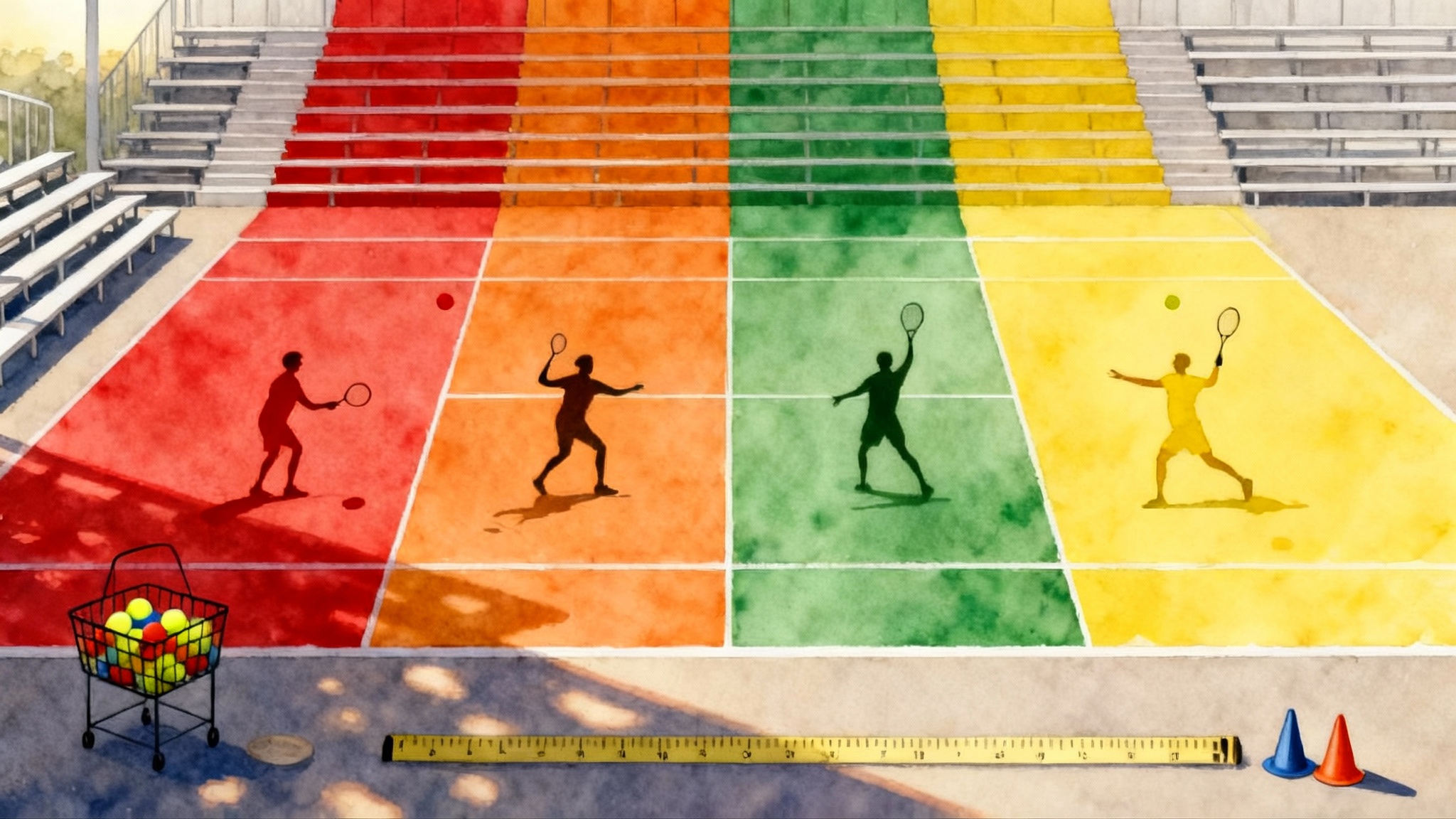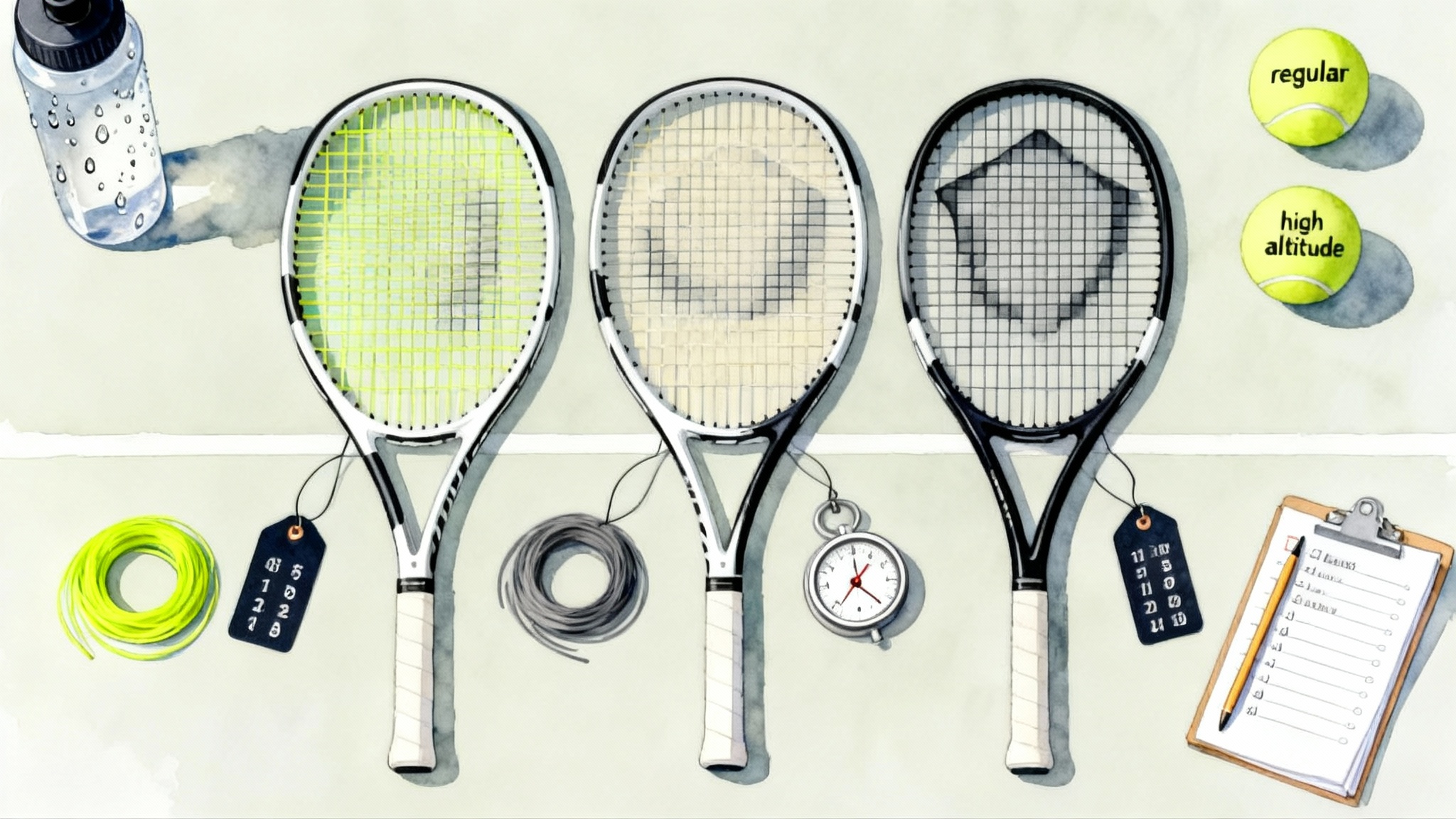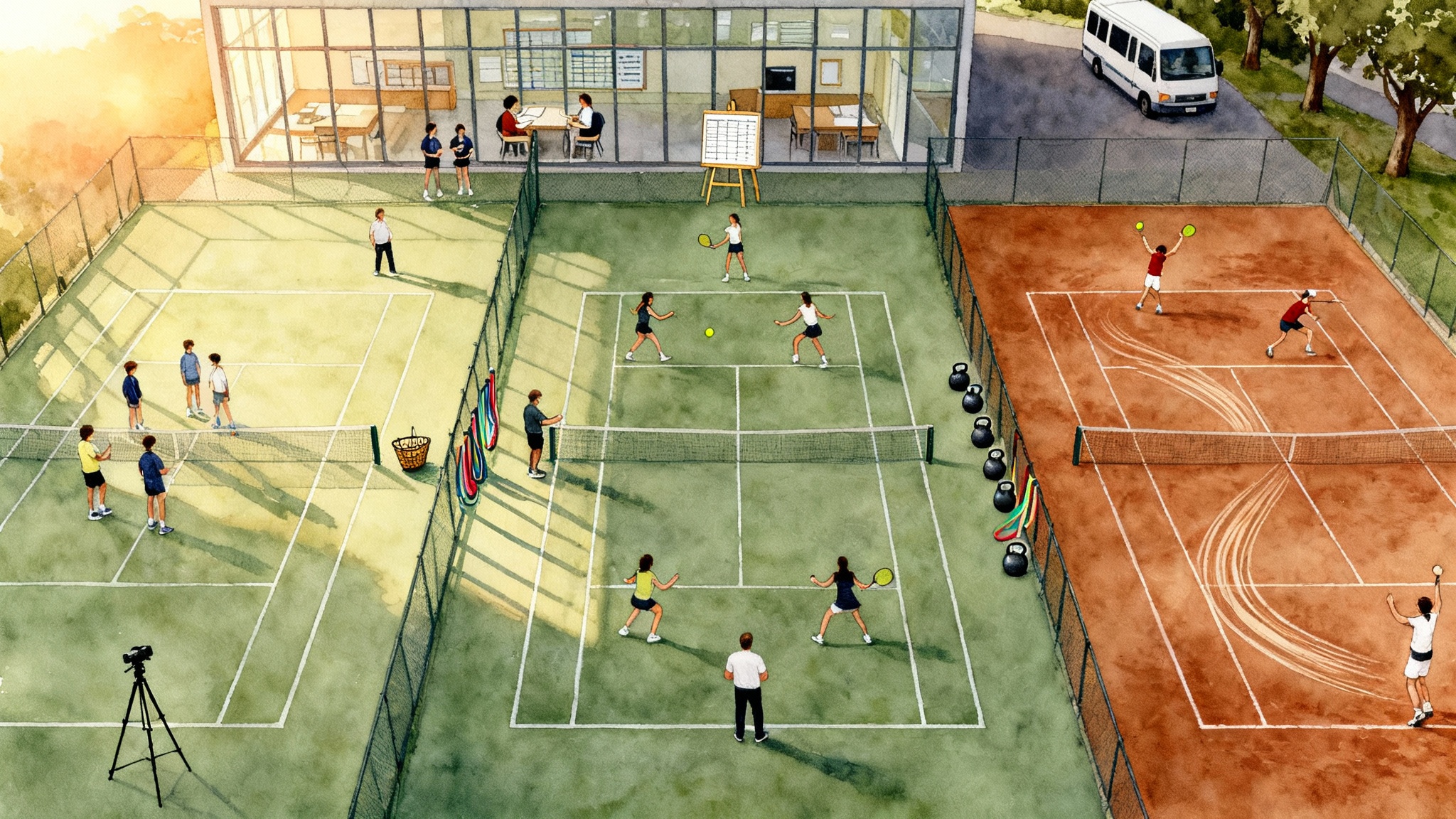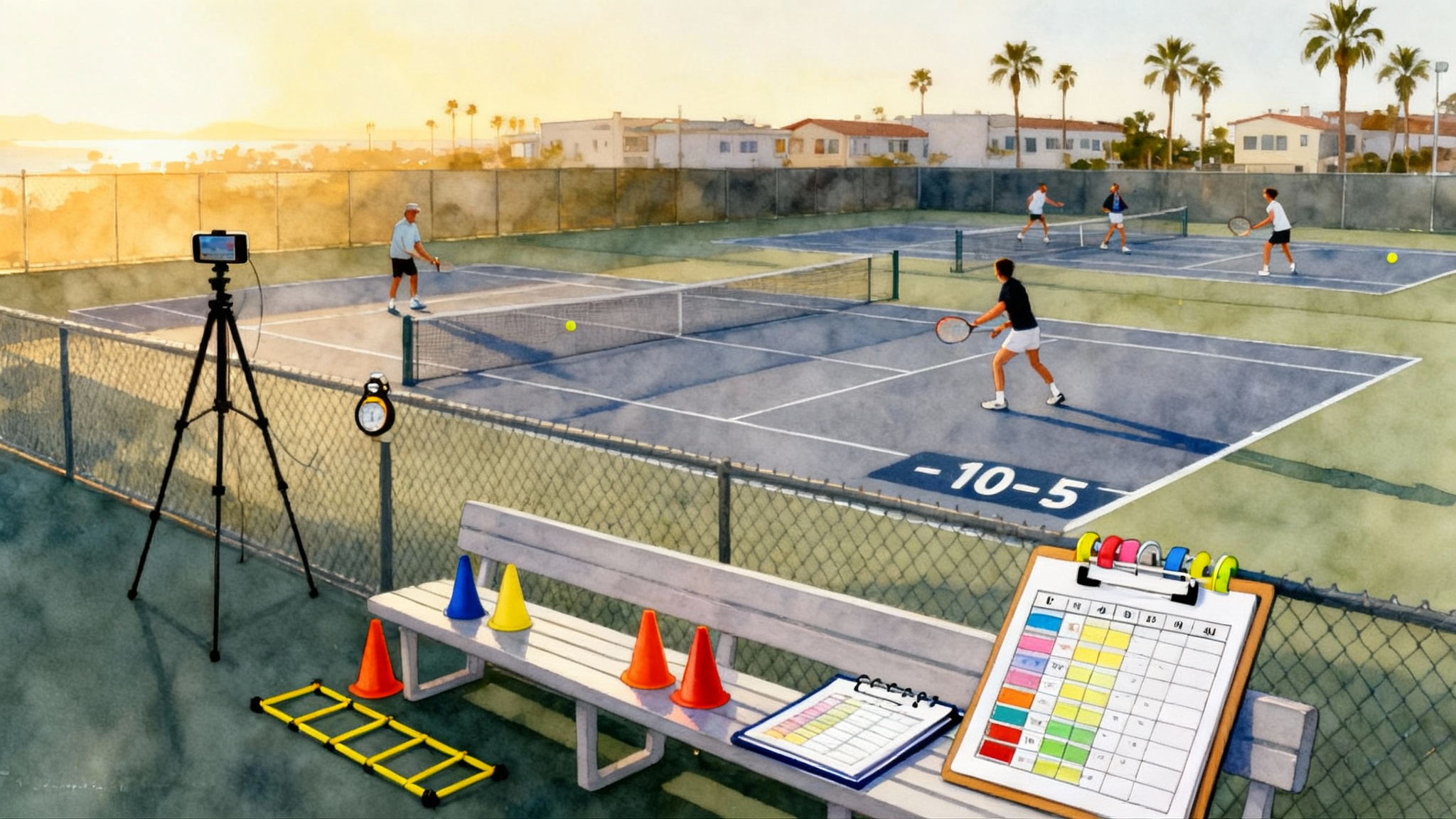Tournament-Day Fueling 2025: Hour-by-Hour Plans for All Ages
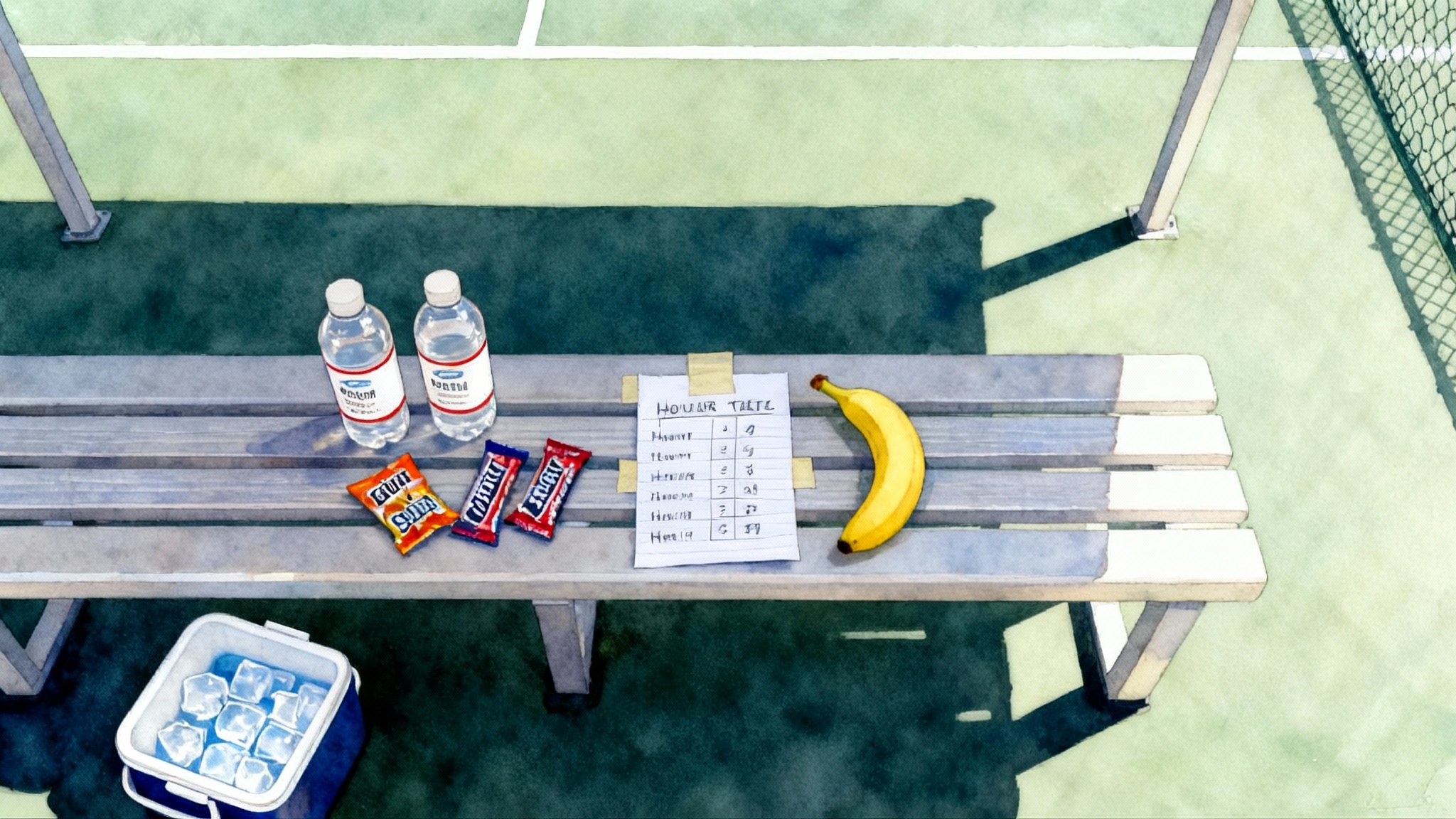
Why match-day fueling is different in 2025
Tournament days compress stress. You may play a morning singles match, a midday doubles match, then a late afternoon decider. Points stop and start, rallies spike intensity, and heat builds on hard courts. Fueling that works for a single 90 minute practice can fall apart when you have multiple matches and limited recovery windows. The solution is a simple, age-specific plan tied to the clock. You will use grams, milliliters, and milligrams, and you will rehearse it before the big day so nothing is a surprise.
This guide gives you calculators, sample menus, and a checklist so you arrive fueled, stay steady between matches, and finish the day without cramps or energy crashes. For weekly scheduling and practice structure, see our smart tennis week templates.
The 24 hour plan at a glance
Think in three phases.
- Phase 1, Prime the engine, 12 to 3 hours before match one: top up carbohydrate, hydrate to euhydration, and keep fiber and fat modest so the stomach empties smoothly.
- Phase 2, On court, during each match: drip feed fluids, sodium, and carbohydrate at set intervals, not when you feel desperate.
- Phase 3, Between matches, the 30 to 90 minute window: rapid refuel, rehydrate, and restore sodium first, then protein if time allows.
Simple calculators you can use today
Use these simple rules, then fine tune based on your own sweat rate and gut comfort. The ranges align with widely accepted sport nutrition guidance on fluid replacement and carbohydrate delivery for intermittent sports like tennis. For background on typical carbohydrate and fluid targets, see the ACSM hydration and fuel guidance.
- Sweat rate test, do this in practice: weigh before and after a one hour hit, track fluid you drink. Sweat rate in liters per hour equals pre weight minus post weight in kilograms, plus fluid consumed in liters.
- Hourly fluid during play: target 70 to 100 percent of your sweat rate, cap at about 1.0 liter per hour, adjust for heat and gut comfort.
- Sodium per hour during play: 300 to 600 milligrams for most players. Salty sweaters or white salt marks on hats can use 600 to 1,000 milligrams per hour. Start at the low end and test in practice.
- Carbohydrate during play: 30 to 60 grams per hour for most. If matches run long or you stack matches, trained guts can use up to 90 grams per hour using a mix of glucose and fructose. Practice in training first.
- Caffeine timing and dose (optional): 1 to 3 milligrams per kilogram of body mass 45 to 60 minutes before match one. Avoid more than 6 milligrams per kilogram. Juniors should use only with parent and coach approval.
Tip for tracking: write your per hour numbers on athletic tape wrapped around your water bottle.
Juniors, hour by hour
Juniors vary widely in age and body mass. The goal is simple foods, steady sips, and no surprises.
- 24 to 12 hours before match one: eat familiar meals with a carbohydrate base. Examples: rice bowl with chicken and soy sauce, pasta with marinara and turkey meatballs, burrito with rice, beans, and mild salsa. Drink water regularly so urine is pale yellow, not clear.
- 12 to 3 hours before: main pre match meal, 1 to 2 grams of carbohydrate per kilogram body mass. Keep protein moderate, about 0.3 grams per kilogram. Keep fat and fiber modest. Examples: white bagel with peanut butter and honey plus a banana, oatmeal made with milk and brown sugar plus applesauce, rice with scrambled eggs and a little cheese. Drink 5 to 7 milliliters of water per kilogram two to three hours pre, then 3 to 5 milliliters per kilogram one hour pre if urine is still dark.
- 60 minutes before: top off snack, 0.5 grams of carbohydrate per kilogram. Portable ideas: applesauce pouch, small banana, fig bars, dry cereal, pretzels. If caffeine is approved, stay low at the 1 milligram per kilogram end.
- During warm up and on changeovers: plan 2 to 3 big swigs of fluid each changeover. For a 45 kilogram junior with a 0.6 liter per hour sweat rate, that could be 150 milliliters per changeover. Use a sports drink providing 30 grams carbohydrate per hour and 300 to 500 milligrams sodium per hour. Bite sized foods work well: a few sips of applesauce, chews, or half a small banana between sets.
- Immediately after match one if another match is due within 2 hours: 1 gram carbohydrate per kilogram plus 300 to 600 milliliters of fluid with 500 to 1,000 milligrams sodium over the next hour. Add 15 to 20 grams of protein if you have more than 60 minutes before the next match. Simple options: chocolate milk, yogurt drink, rice balls with soy sauce, white bread sandwich with turkey and jam.
- Evening after final match: balanced dinner and a salty carbohydrate like ramen with egg, rice with soy sauce, or pasta with parmesan. Aim for 20 to 25 grams of protein before bed if appetite allows.
Parent packing tip: label bottles by hour and preload one bottle with a sports drink powder, one with plain water.
College players, hour by hour
College match days bring higher intensity and bigger sweat rates. Plan with precision and treat changeovers like pit stops. Pair your routines with first four shots tactics so your physical plan supports point patterns.
- 24 to 12 hours before: a carbohydrate forward dinner with 1.5 to 2 grams per kilogram and a sodium conscious approach. Add extra salt to the meal if you sweat heavily. Drink to thirst plus regular sips.
- 3 to 4 hours before match one: 2 grams carbohydrate per kilogram, 0.3 grams protein per kilogram, low fiber and fat. Example menus: pancakes with maple syrup and eggs, rice bowl with lean beef and soy sauce, bagel with jam and a yogurt. Drink 5 to 7 milliliters per kilogram two to three hours pre.
- 60 to 30 minutes before: 0.5 grams carbohydrate per kilogram from a fast digesting source. Coffee or caffeine capsule at 1 to 3 milligrams per kilogram is optional. If you are sensitive, use 1 milligram per kilogram.
- During match: use a dual bottle system. Bottle one is sports drink that gives 30 to 45 grams carbohydrate per hour and 500 to 800 milligrams sodium per hour. Bottle two is water. Sip both every changeover. Chews or gels can add 15 to 20 grams carbohydrate each set.
- Between back to backs, less than 2 hours: aggressively rehydrate at 1.5 liters per kilogram of body mass lost over the next 2 to 4 hours, understanding you may only get 60 to 90 minutes. Use salty drinks or sodium capsules to hit 1,000 to 1,500 milligrams of sodium in that first hour. Carbohydrate target is 1 to 1.2 grams per kilogram in the first hour. Add 20 to 30 grams of protein only if gut feels settled and you have more than 60 minutes.
- Evening: large mixed meal with starch, lean protein, vegetables, and extra salt if sweat losses were high. Before bed, 20 to 40 grams of casein rich protein like Greek yogurt to support recovery.
Adults, hour by hour
Adult league and open players juggle work, family, and travel. The goal is predictability with portable foods.
- 24 to 12 hours before: plan a carbohydrate forward dinner that you tolerate well. Examples: pasta with marinara and grilled chicken, sushi with rice and soy sauce, rice with tofu and teriyaki sauce. Do not overdrink water late at night.
- 3 to 4 hours before: 1 to 2 grams carbohydrate per kilogram plus 0.3 grams protein per kilogram. Keep fiber low. Drink 5 to 7 milliliters per kilogram two to three hours pre.
- 60 minutes before: 0.4 to 0.6 grams carbohydrate per kilogram as a snack. Coffee is fine if it is part of your normal routine. Limit caffeine to 1 to 3 milligrams per kilogram.
- During match: most adult players do well with 400 to 800 milliliters fluid per hour, 300 to 600 milligrams sodium per hour, and 30 to 45 grams carbohydrate per hour. Use changeovers to sip and bite. Think sips of sports drink, a few chews, or a small swig of applesauce.
- Between matches: if the gap is less than 2 hours, prioritize sodium and carbohydrate first, then protein. If more than 2 hours, add 20 to 30 grams of protein.
Between match recovery playbook
Use this simple order of operations when you step off court.
- Weigh quickly if a scale is available. The difference in kilograms is liters of fluid lost.
- Start sipping a salty drink immediately. Aim for 500 to 1,000 milligrams sodium in the first hour.
- Hit 1 to 1.2 grams carbohydrate per kilogram in the first hour. Large body mass players can split this into two rounds 20 minutes apart.
- Add 20 to 30 grams protein if time allows and your gut feels settled.
- Cool the body: shade, cold towel, or ice on neck and forearms.
- Set an alarm for 15 minute sips so you do not forget.
Rapid options that do not fight your stomach: chocolate milk, yogurt drink, sports drink with a banana, rice balls with soy sauce, pretzel roll with turkey and jam, applesauce pouches, recovery shake plus pretzels.
Heat index game plan and cramp prevention
Heat and humidity change everything. The heat index combines temperature and humidity to estimate how hot it feels. Check your event forecast and use the National Weather Service heat index chart to plan.
- Moderate heat index, 80 to 90 degrees Fahrenheit: stick to your baseline plan. Start at the low end of sodium targets.
- High heat index, 91 to 103 degrees Fahrenheit: increase fluids toward the top of your hourly range, increase sodium by 100 to 200 milligrams per hour, and add cold fluids and ice towels. Consider a pre cooling strategy with an ice slushie 20 minutes pre match.
- Very high heat index, 104 degrees Fahrenheit and above: move warm up to shade, reduce clothing layers, use cold towels on neck and forearms, and schedule more frequent sips. If you cramp, use gentle stretching and sip a salty drink. Do not chug plain water.
Cramp prevention checklist for heavy sweaters: confirm your sodium plan, add a saltier lunch or broth, keep carbohydrate flow steady so you do not underfuel, and prepack a 1,000 milligram sodium bottle for emergencies.
Packable menus and shopping list
Pack foods that are simple, portable, and familiar. Build kits that live in your bag so you are never stuck with only concession stand candy.
- Breakfasts for 3 to 4 hours pre: plain bagel with peanut butter and jam, oatmeal with milk and brown sugar, pancakes with syrup and eggs, rice with eggs and soy sauce, yogurt with granola and honey.
- Top off snacks for 60 minutes pre: bananas, applesauce pouches, graham crackers, fig bars, rice cakes with honey, pretzels, dry cereal cups.
- On court bite sized carbs: chews, gels, honey packets, small banana halves, bite size dates, applesauce squeeze packs.
- Salty hydration: sports drink powders or ready to drink bottles, electrolyte tablets or packets, tomato juice if you tolerate it, broth in a thermos for cold weather days.
- Recovery between matches: chocolate milk, yogurt drinks, deli turkey on white bread with jam, rice balls, sushi rice triangles with soy sauce, smoothies.
Shopping list by category:
- Carbohydrate staples: white rice, pasta, bagels, tortillas, fig bars, pretzels, applesauce pouches, instant oatmeal, honey, rice cakes.
- Protein add ons: Greek yogurt, milk, turkey slices, eggs, tuna packets, whey or soy protein powder.
- Sodium sources: table salt, soy sauce packets, sports drink powder, electrolyte capsules.
- Fluids and gear: reusable bottles, shaker bottle, small cooler, ice packs, zip bags.
The gear checklist that prevents cramps and energy crashes
- Two large bottles labeled Drink 1 and Drink 2 with volume marks.
- Pre measured sports drink powder in small zip bags, one per hour.
- Electrolyte capsules if you are a salty sweater.
- Applesauce pouches, chews, or gels counted for each set you expect to play.
- Portable scale if your team uses rapid weigh ins.
- Cooling towel and a small soft cooler with ice packs.
- A permanent marker to write hourly targets on your bottle.
- Wet wipes and a small trash bag so you keep the bench clean.
When and how to use caffeine and electrolytes
Caffeine can sharpen alertness and perceived effort, and it may help reaction time on returns. Start with 1 milligram per kilogram of body mass 45 to 60 minutes pre match and evaluate sleep and jitters. Avoid new caffeine on finals day. Do not exceed 3 milligrams per kilogram unless you have tested it in training and have no side effects.
Electrolytes are not only for ultra runners. For tennis in heat, sodium is your anchor because it helps retain the fluid you drink. Start with 300 to 600 milligrams per hour. If you see salt crust on clothing, you cramp often, or you gain body mass during matches from overdrinking, move toward 600 to 1,000 milligrams per hour. Record what works on a note in your phone.
Sample day timelines
Use these templates as a starting point. Adjust quantities to your calculators. If you are planning a season of events, learn how to plan tournaments without burnout.
Juniors, 8 a.m. match, 1 p.m. second match:
- 5:00 a.m. breakfast: bagel with peanut butter and honey, banana, 500 milliliters water.
- 6:30 a.m. top off: applesauce pouch, 250 milliliters sports drink.
- 7:40 a.m. warm up: 200 milliliters sports drink.
- 8:00 to 9:30 a.m. match: 500 to 700 milliliters fluid total with 30 to 45 grams carbohydrate and 300 to 500 milligrams sodium per hour. One small banana at the 45 minute mark.
- 9:40 a.m. recovery: chocolate milk, pretzels, 500 milligrams sodium.
- 10:30 to noon: sip 400 milliliters water, then 400 milliliters sports drink, plus a yogurt if gut is calm.
- 12:30 p.m. top off: fig bar, 200 milliliters sports drink.
- 1:00 p.m. match two: repeat on court plan.
College players, 10 a.m. match, 3 p.m. second match:
- 6:30 a.m. breakfast: pancakes with syrup and eggs, 750 milliliters water.
- 8:30 a.m. top off: gel or chews for 20 grams carbohydrate, 250 milliliters sports drink, 1 to 3 milligrams per kilogram caffeine if desired.
- 10:00 to 11:45 a.m. match: 700 to 1,000 milliliters per hour across two bottles. Sodium 600 to 1,000 milligrams per hour. Carbohydrate 45 to 60 grams per hour.
- Noon to 1:00 p.m. rapid refuel: 1 gram per kilogram carbohydrate, 1,000 milligrams sodium, 750 milliliters fluids. Add 25 grams protein if gut is calm.
- 1:00 to 2:30 p.m. maintain: small sips and salty bites. If urine is clear, reduce water and switch to sports drink only.
- 2:30 p.m. top off: applesauce pouch and 250 milliliters sports drink.
- 3:00 p.m. match two: same on court plan.
Adults, noon match only:
- 8:00 a.m. breakfast: oatmeal with milk and brown sugar, toast with jam, 600 milliliters water.
- 11:00 a.m. top off: banana and 250 milliliters sports drink. Optional coffee earlier in the morning if part of your routine.
- Noon to 1:30 p.m. match: 500 to 800 milliliters fluid per hour, 300 to 600 milligrams sodium per hour, 30 to 45 grams carbohydrate per hour.
- After: chocolate milk and pretzels, then a balanced lunch.
Common pitfalls that derail performance
- New foods on tournament day: your gut is already stressed. Rehearse everything in practice.
- All water and no sodium: leads to diluted blood sodium and heavy legs. Make sure at least one bottle has sodium.
- Overreliance on caffeine: it cannot fix underfueling. Carbohydrate and sodium are the base layer.
- Waiting to drink until thirsty on hot days: schedule sips each changeover.
- Fiber bombs before matches: salads and heavy beans may cause cramps. Save them for dinner.
Download templates and book a consult
Do not leave match day to chance. Grab our ready to print match day meal plan templates and bottle label cheat sheets, then personalize them with your own numbers.
- Download the match day meal plan templates.
- Book a 20 minute academy nutrition consult to set your exact carb, sodium, and caffeine plan.
Final word
Fuel like you play, with intention on every point. Build your calculator numbers in practice, stock your bag, and treat each changeover as a chance to stay ahead of fatigue. The details add up. When the third match of the day turns into a tiebreak, you will still have hands that are steady, legs that respond, and a clear plan you trust.

